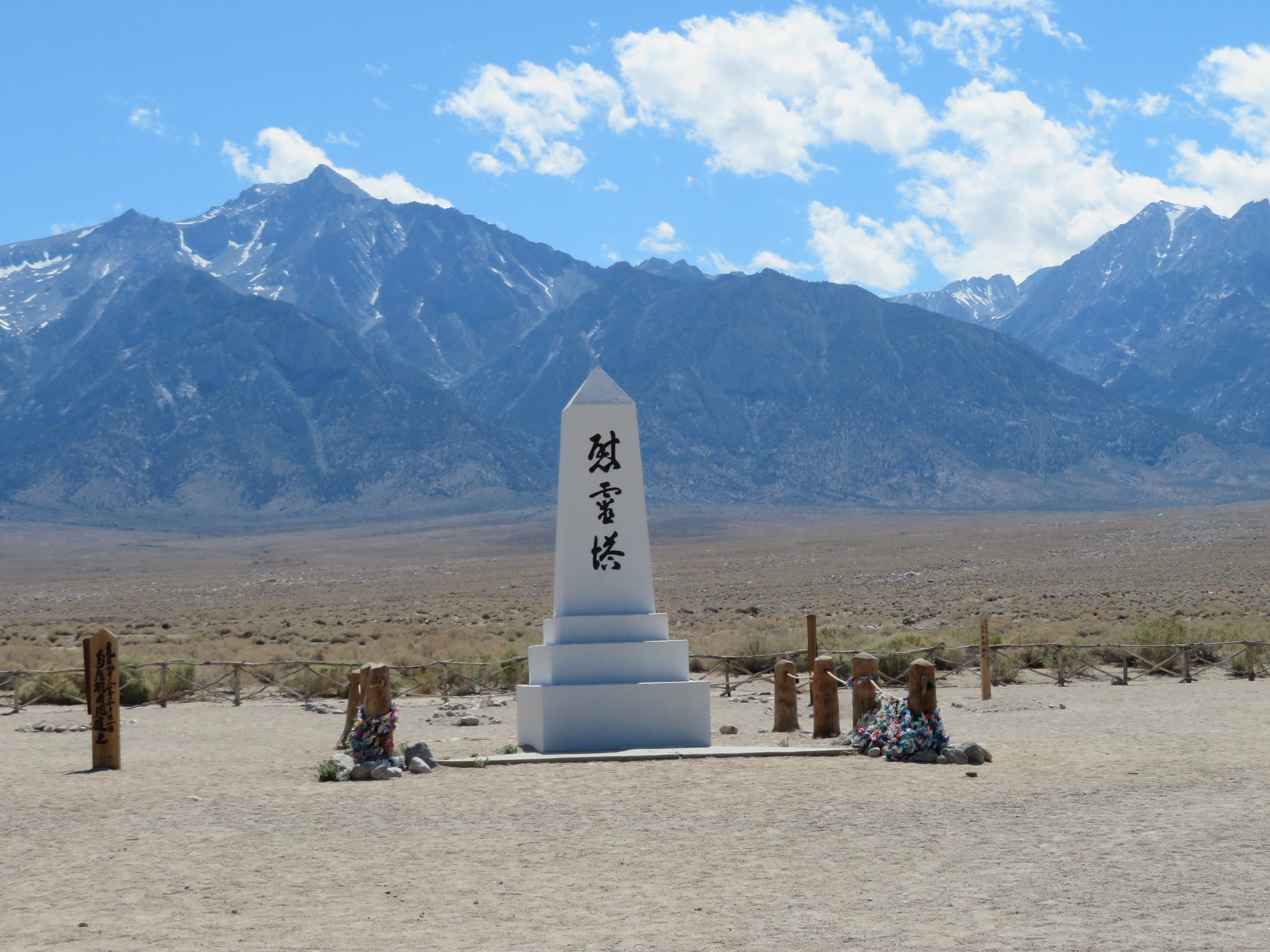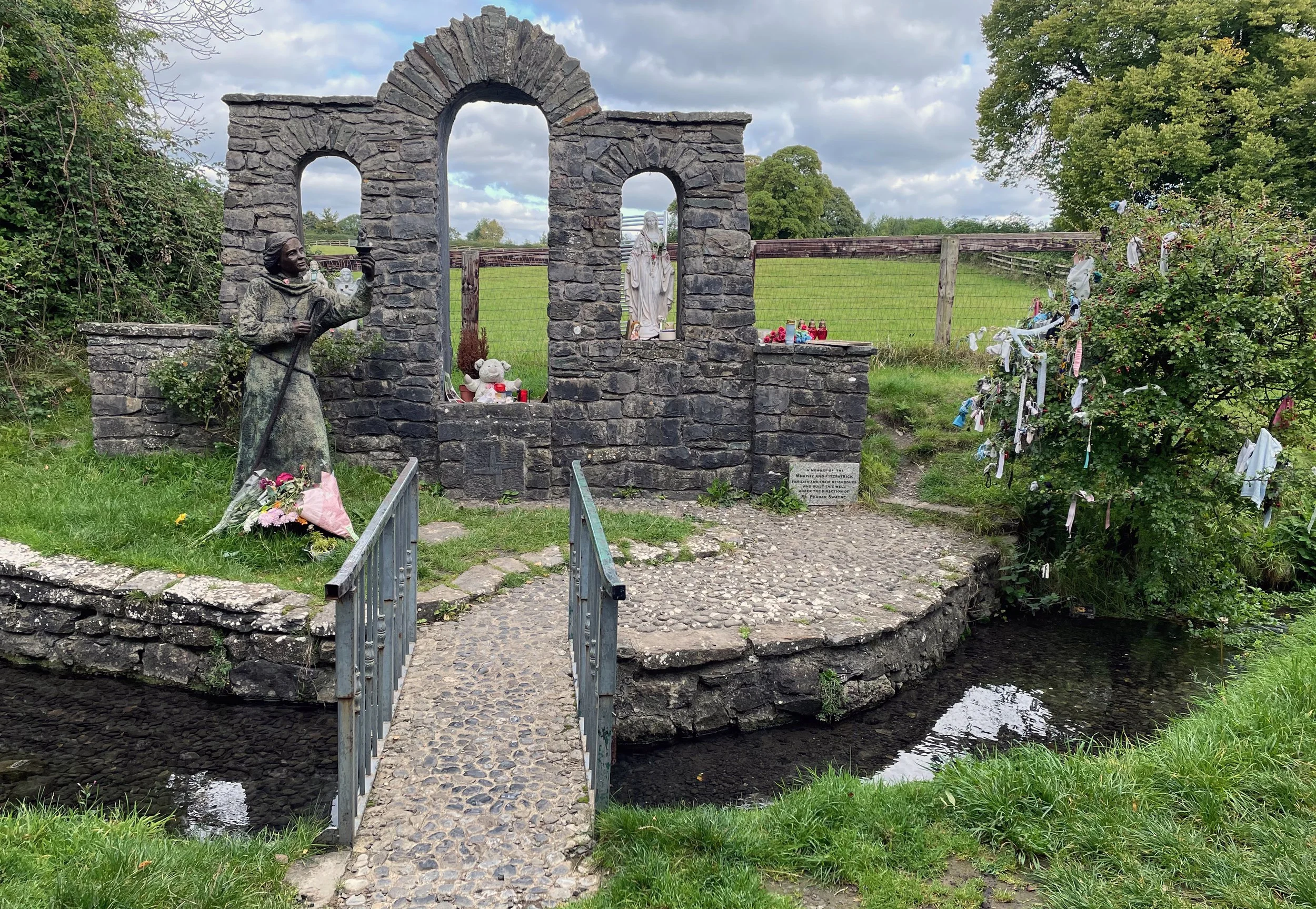Manzanar: Heartbreak and Beauty
By Carolyn Handler Miller
My husband Terry and I were on the way to Bishop, California, to enjoy the city’s annual celebration of long-eared equines, known as Mule Days. Driving up Highway 395, past the town of Lone Pine, I spotted a turnoff sign for Manzanar, a site where Japanese-Americans were interred during World War II. A few days later, we returned to check it out.
A solid rock gatehouse was on one side of the entrance and on the other side was a sign: “Manzanar War Relocation Center.” A few feet past the entrance, even more disturbing: “STOP. MILITARY POLICE.” A menacing guard tower loomed in the distance. I felt a chill. Innocent people were forced to live here against their will, guarded by armed soldiers.
The road led to a bulky building that was once the internment center’s high school auditorium. Now a visitors’ center, its orientation map revealed that the site also contains two reconstructed barracks, a mess hall and a latrine, plus other features. Manzanar is one of several national parks that interpret historic locations and strive to tell their story, even if it reflects a dark period in America’s history. Soon after Pearl Harbor was bombed, 112,000 Japanese-Americans—none of whom had any part in the bombing or were shown to have had hostile intentions against the US—were relocated to internment centers. Ten thousand came here.
The visitors’ center is a painful introduction to Manzanar, filled with artifacts, displays, historic photos, and moving videos of people recounting their years of internment. What struck me the hardest, as a Jewish-American, was the scale model of the camp, showing its 504 barracks, which resembled scale models of concentration camps I’ve seen in Holocaust museums. “Like Auschwitz without the ovens,” Terry said bitterly. But at Manzanar, at least, inmates weren’t starved to death or murdered in gas chambers. They were given food, children attended school, and no one was worked to death.
The camp was largely torn down after the war, but several buildings were carefully reconstructed, built to the exact measurements, and employing the same materials originally used at Manzanar. Barracks were made of scrap wood and tar paper, uninsulated, so they offered no protection from the sand and constant windy conditions of the high desert. Dust relentlessly blew in through openings in the floor and cracks in the walls. The barracks were cold in winter, hot in summer. On a hot day, we felt the unrelenting wind and heat and had “souvenir” grit in our eyes and ears.
The first barrack displayed the barren living space greeting the new arrivals, furnished solely with cots. No bathroom. No kitchen. With 8 people in each “apartment,” there was also no privacy. If you didn’t have 8 people in your family, you had to share the space with complete strangers.
The second barrack displayed the improvements some families were able to make over time. They contained hand-made furniture, bookshelves and curtains. Floors and walls were covered in wind and dust-blocking materials. This was better, but certainly not like the homes people had been forced to leave.
Instead of bathrooms, internees had to use gender-separate communal latrines. The reconstructed women’s urinal featured an ugly row of toilets all with no walls or partitions between them, very much like the toilets at Auschwitz. For modest Japanese women, using these facilities was a humiliating experience. I would have hated it, too.
The mess hall was equally bare bones. People received their food cafeteria-style and, like food fed to U.S. soldiers, it was heavy on meat and potatoes, wieners, and macaroni, usually badly cooked. Many could not eat or digest the unfamiliar food.
In the video testimonials throughout the camp, people told of their experiences, and I felt tears running down my cheeks as I watched them. Several remembered arriving, dressed in their best clothes and hopeful the conditions would be decent. They were shocked to see the crude barracks set in a sandy, treeless, high desert. Others talked of what their families had lost in this relocation: a thriving nursery, a medical career, a house, a car the father had proudly been able to purchase. A woman recollected how her mother went to the apple orchard at night and wept in despair that her children were forced to live here.
Yet somehow people found ways to create beauty and to make their lives more tolerable. Some internees, skillful woodworkers, built handsome chests of drawers, tables, and chairs, highly polished and lacquered. Women searched for shells in the sand and crafted delicate pieces of jewelry. They sewed cheerful clothes for their poor children, kids who had nothing to play with, and even established a “toy library” for eager children.
Large projects were also undertaken. Dismayed at how people had to stand in line in the hot sun while waiting for the mess hall to open, one man decided a pond outside the mess hall would soothe their discomfort. The pond became a community project. A former landscape designer created the plans, while others found rocks and plants to make it look more natural. They even managed to obtain carp and trout to swim in their pond. In time, different barracks would compete with each other to make pretty gardens outside their living quarters.
Even more ambitious was the beautiful 1.5-acre park the residents constructed, incorporating traditional Japanese features like a waterfall, a lake, and a wooden bridge. It became a cherished oasis in the dry desert. By the time we visited, only the wooden bridge remained, and the concrete shell of the lake. The lovingly tended flower beds did not survive.
Our last stop was the cemetery, marked by a poignant white obelisk, inscribed with 3 Japanese characters translating to soul consoling tower. Over 145 Japanese Americans passed away at Manzanar. The remains of only six individuals still lie here. Today, people gather around the obelisk for the annual Manzanar Pilgrimage. The former residents vowed that injustices like Manzanar would never happen again, and they, their children and grandchildren gather each year to renew that pledge. I, too, pray we never forget.
As we drove away, I felt a surge of helpless anger at the unwarranted incarceration of Japanese Americans. Manzanar stands as a reminder of what can happen when we don’t stand up to injustice.
Carolyn Handler Miller (www.carolynhandlermiller.com) is a writer who works across a variety of media. Originally beginning her career as a newspaper reporter and magazine journalist, Carolyn's projects span TV shows and specials, feature films, books and new media. She is one of the pioneering writers in the field of interactive narrative, where she has contributed to over 50 projects as a writer, writer-story designer, and consultant. She is the author of “Digital Storytelling: A Creator's Guide to Interactive Entertainment” (Focal Press), now in its fourth edition.





